Photo

A really strong blue - Rowena Crest #OregonExplored via Instagram https://instagr.am/p/CELHlXjlvb7/
11 notes
·
View notes
Text

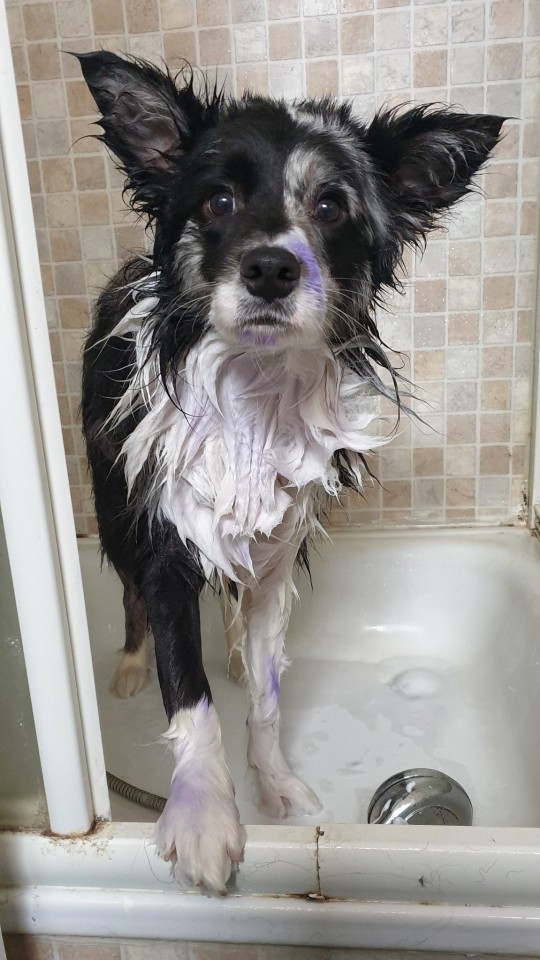

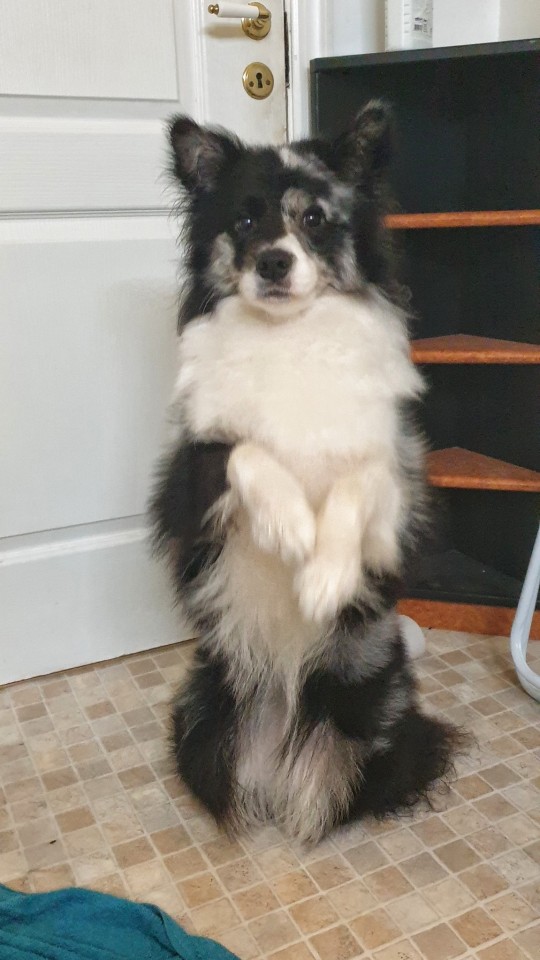
Bath day!
147 notes
·
View notes
Text
Throwback to the time my poor German teacher had to explain the concept of formal and informal pronouns to a class full of Australians and everyone was scandalised and loudly complained “why can’t I treat everyone the same?” “I don’t want to be a Sie!” “but being friendly is respectful!” “wouldn’t using ‘du’ just show I like them?” until one guy conceded “I suppose maybe I’d use Sie with someone like the prime minister, if he weren’t such a cunt” and my teacher ended up with her head in her hands saying “you are all banned from using du until I can trust you”
165K notes
·
View notes
Text
Iroh and Sokka shopping together
Iroh and Sokka exchanging jokes
Iroh teaching Sokka how to play the tsungi horn and Sokka teaching Iroh how to throw a boomerang
Iroh and Sokka discussing politics during a friendly game of Pai Sho
Sokka telling Iroh everything Zuko has done when he joined the gaang and Iroh trying to hold back his tears because he’s so damn proud of his nephew
Iroh trying to brew tea the Water Tribe way and Sokka holding back his tears because it’s exactly how his mom used to make it
17K notes
·
View notes
Link
Listen, I know it’s a B*zzfeed article, but if you listen closely you’ll hear the neglected screams of the Myalgic Encephalomyelitis community and all the researchers who fought for decades to get funding for this sort of thing, but because the illness got re-branded as “chronic fatigue syndrome” and WRONGLY classified as a purely psychological disorder, and not a complete autonomic nervous system collapse following a major event (trauma, prior viral illness etc), we’re both woefully behind and wholly unprepared for the mass disability event that is about to follow Covid-19 if steps aren’t taken Immediately to correct the guidelines being handed out by doctors to “long haul” Covid-19 patients when it comes to self care and long term recovery.
Jennifer Brea over on Twitter has been talking extensively about her experiences with having ME/CFS and then contracting Coronavirus on top of that (source). She also regularly boosts the experiences of others, and is one of the most forefront advocates for ME/CFS to be taken seriously by medical professionals worldwide, and her documentary www.unrest.film/ has been paramount to raising awareness to the neglect and medical abuse many people with chronic conditions face.
If you’re a “long haul” Covid-19 sufferer and you’re finding my blog because of the various chronic fatigue things I’ve posted over the years, I’m so sorry. We think I got it back in March/April, and while we also think my MCAS meds might have helped me recover better, it’s been a rough few months, even by my standards. But please know you are not alone. Reach out to the ME/CFS communities online. You’ll find support and resources that may help you affirm that you’re not alone or crazy and that yes, some of the things your doctors are recommending you to do, like “kick starting your recovery with exercise” is in fact making you worse. Many, many, many people with ME/CFS suffer from severe and debilitating exercise intolerance, especially if their ME/CFS comes with a side helping of POTS (Postural orthostatic tachycardia syndrome). My exercise intolerance is made doubly worse by suffering from a mast cell dysfunction (MCAS), which means if I exercise too hard or too much, I can trigger an episode of anaphylaxis and go into shock. Sounds bonkers I know, but as anyone with a chronic condition can tell you, the body is capable of wild and often terrifying things that as many, many people are now finding out, most doctors are either ill equipped to deal with or even believe in.
But for whatever it’s worth, I believe you. I believe you got sick, and you’re still sick, and if I can give you one piece of advice from one chronically sick person to another, rest. Please, rest, please don’t push yourselves. Be kind and gentle to yourself. Yes you might end up with some deconditioning, but you cannot show this thing who is boss by running a marathon or climbing a mountain. Health doesn’t work that way, no matter what the moral purists and healthful bloggers say. Be gentle, be kind. Your body is going through a trauma not yet fully understood by medical science, and you cannot expect to bounce back the way you once did. I’m sorry. You didn’t do anything wrong. You didn’t do anything to deserve this. It’s just how things are. But you’re not alone, and I hope there is some comfort in that for you.
7K notes
·
View notes
Photo

Artist Gabriela Hedrejci “Queen”
On Exhibition at the Galeria Przy Teatrze
49 notes
·
View notes
Photo
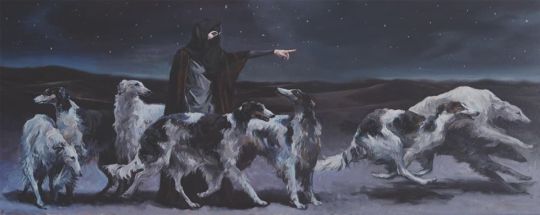
Artist Gabriela Hedrejci “Run”
On Exhibition at the Galeria Przy Teatrze
88 notes
·
View notes
Photo


Hryhorii Zorik( Ukranian, b. 1958) Provincial Grandees
11 notes
·
View notes
Photo

George Lavroff (1805-1991) Made in France, 1925
9 notes
·
View notes
Text
Dr Nai-Chieh Liu, first author of the study, says: “Breeding for open nostrils is probably the best simple way to improve these breeds. Dog breeders should also avoid using dogs with extremely short muzzles, wide faces, and thick necks. These traits are all associated with increased risk of having BOAS.”
Joint lead author Dr David Sargan adds “At this moment there is no conclusive way of predicting whether any individual pug or bulldog will develop breathing difficulties, so we are now looking for genetic tests that may help breeders get rid of BOAS more rapidly.
“The best advice we can give to owners of short-nosed dogs is to make sure you get your dog checked annually for any potential difficulties in breathing, even if you have not yourself observed any in your dog, and to keep your dog fit and not let it get fat.”
41 notes
·
View notes
Text
Does my bird recognize me?
I was asked the other week if I think the birds I work with “know” who I am and can distinguish me from other humans. Personally, I can tell that the hens and turkeys I train at the research laboratory, the raptors I work with in the evenings, and my own pet chickens behave towards me in a way that’s different from how they react to other human beings, suggesting that they do recognize me as an individual. But, as a someone working in behavioural research and running a science-based blog, of course I’m not going to leave you all with nothing but personal anecdotes!
Hypothetically, chickens (and other birds that live in complex social groups) are capable of telling the difference between human faces, at the very least. We can make this assumption based on the fact that 1) individuals living in societies with selective/affiliative relationships/hierarchies (as chickens most certainly do) have to be able to differentiate between each other and remember each others’ features (eye position, beak length, feather colour/pattern, movement/behaviour pattern, vocalizations, etc.) to survive (I’ve previously touched on this here). If no one recognize anyone and keep track of who’s above and below who, there would be total chaos! 2), Pigeons have been trained to discriminate not only between different people’s faces, but between different genders and emotions as well (Watanabe and Masuda, 2010). There are no official scientific reports of similar tests being done with chickens that I could find, but based on their behavioural biology, and the things that I’ve personally trained chickens to do for my research, I’m confident that they’d be more than capable of it, too.

(Photo from https://experiment.com/projects/how-do-birds-see-the-world)
So, while it’s more than likely that chickens can discriminate between different human faces, this does not strictly mean they recognize their subject as individuals, per se. Individual recognition requires that the bird can recognize someone as a whole, and not just a forward-facing portrait of that person, as most recognition experiments do (Tibbetts and Dale, 2007). The bird has to be capable of forming a mental image of an individual from any angle, and also be able to use other identifying features other than the face, such as the person’s mannerisms and voice, like I mentioned above. Apparently, pigeons have difficulty with this. And again, there’s nothing in the literature for it using chickens as a subject. But, I think any backyard poultry owner who’s experienced the joy of their birds eagerly running over for treats or cuddles while ignoring other humans would strongly agree that they recognize their owner (and have positively associated them with food and maybe even affection, no less!), especially if you hatch your own chicks and have them imprint on you.
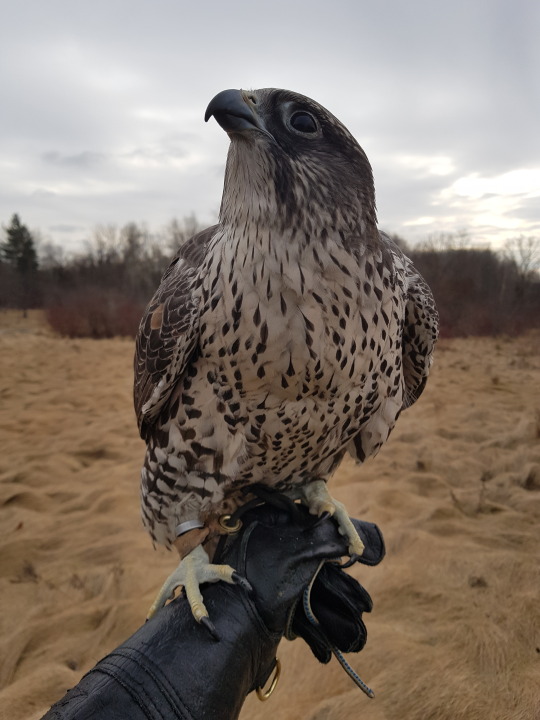
(Gyrfalcon photo by me, please ask before re-posting)
On a side note, let’s consider non-social birds, like raptors. Most raptors, with a few exceptions, live solitary lives in the wild outside of breeding season. They don’t live in large groups, and don’t have to deal with pecking orders. At the very least, they might have to remember if they’ve had to chase away the same intruder from their territory before, or if they chose the same partner to mate with the previous year. When I’m doing shows/presentations with my raptors, people frequently also ask me if the bird I’m holding “knows” me. I respond by saying that it’s more likely that things are the other way around - I know the bird very well. I know how to approach and handle the bird in the ways that make them feel most comfortable, I know what the possible stressors are in its environment that sets them off that I have to work to avoid, and all of their other quirks. All of this knowledge/understanding of the bird helps me give them as positive an interaction with me as possible during every training session, resulting in them being more comfortable with me, as opposed to a novice trainer/someone who has never worked with that specific bird before. This may also partly factor into why chickens behave differently in response to certain owners, compared to other humans they encounter. For example, a big part of the reason that my chickens seem to always want to be near me (other than the fact that I’m basically a constant source of treats), but avoid my parents, probably has to do with the fact that I specifically know how to walk up to/pet/feed them without accidentally startling or intimidating them.
As another side note, some birds discriminate and remember human faces for years, without tons of training involved. These include species in urban environments that often interact with humans. Mockingbirds that are disturbed by a human in a mask while they’re sitting on their eggs will display increasingly threatening behaviour (alarm-calling and mobbing) with each day the masked intruder appears (Stehlin et al., 2017). However, they behave towards someone in a new mask as if they’ve only encountered them for the first time. Again though, the researchers couldn’t prove for certain whether this was due to recognition, or just discrimination.
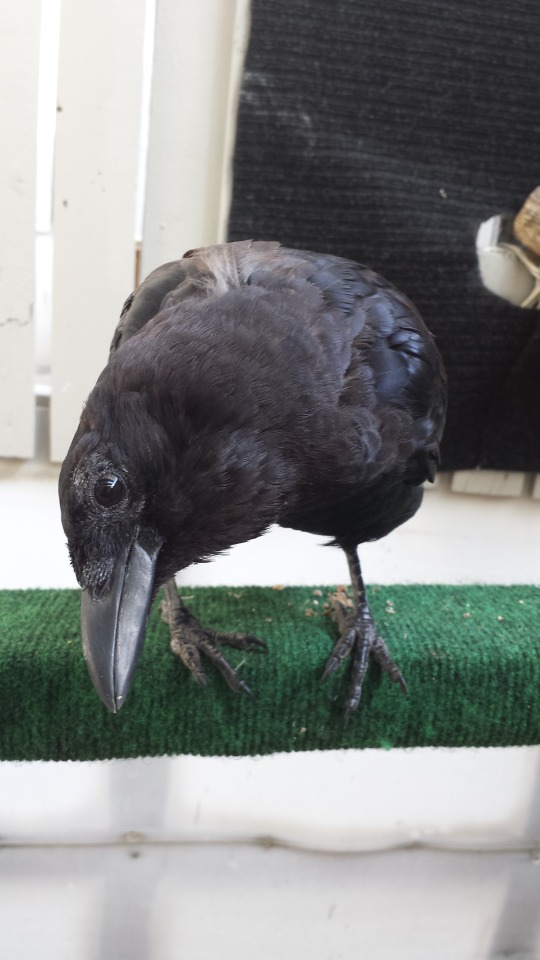
(American crow photo by me, please ask before re-posting)
A more famous example here on tumblr might be a similar experiment done with crows. Researchers wore masks and trapped crows, who responded by making vocalizations used as threats to ward off predators. Amazingly, these crows made the same calls if they saw someone wearing the same mask three years later (Marzluff et al., 2010). It’s also been shown that different regions of their brains respond to different emotional states in response to the mask (Marzluff et al., 2012). In another experiment, one group of crows was trapped by a researcher wearing a “threatening” mask, while the other group was captured, but also fed by a researcher wearing a “caring” mask. Seeing either the threatening or caring mask would activate different neural circuits in the crows’ brains - the first associated with negative emotions, and the second with reward. It’ll probably be a long time before any lab gets the funding to do PET scans on chickens, but until then, I think us doting chicken-lovers will happily agree that our birds know and recognize us!

(Photo from https://www.youtube.com/watch?v=O7W95cXU24E)
References:
Watanabe S, Masuda S. Integration of auditory and visual information in human face discrimination in pigeons: Behavioral and anatomical study. Behavioural brain research. 2010 Feb 11;207(1):61-9.
Tibbetts EA, Dale J. Individual recognition: it is good to be different. Trends in Ecology & Evolution. 2007 Oct 1;22(10):529-37.
Stehlin JA, Crook-Hill J, Bailey B. Human Facial Recognition by Northern Mockingbirds. Papers & Publications: Interdisciplinary Journal of Undergraduate Research. 2017;6(1):10.
Marzluff JM, Walls J, Cornell HN, Withey JC, Craig DP. Lasting recognition of threatening people by wild American crows. Animal Behaviour. 2010 Mar 1;79(3):699-707.
Marzluff JM, Miyaoka R, Minoshima S, Cross DJ. Brain imaging reveals neuronal circuitry underlying the crow’s perception of human faces. Proceedings of the National Academy of Sciences. 2012 Sep 6:201206109.
982 notes
·
View notes
Video
Happy Sunday, everyone! And, thank you for 1000 followers :) I promised I’d write up a new post for those of you who just started following me, so enjoy this video of one of my black sex-link hens, the Queen, being cute and dust-bathing in the sun.
I think everyone here on birdblr loves to watch their birbs bathe, whether it’s done in water or a nice patch of dirt. Some bird species have no problem bathing in either, but most, if not all gallinaceous birds (poultry, including chickens and quails) will only dustbathe. Why do they do it - how does rolling around in dirt keep you clean?
The most common answer people will give you is that dustbathing keeps ectoparasites - mites and lice - off a chicken’s skin and feathers. While this has been common knowledge among both chicken farmers and backyard chicken owners for decades, you might be surprised to learn that no one ever actually tested this scientifically until 2012. There are possibly hundreds of studies which basically tell us that dry dirt or sand is just like dry shampoo for the birds, absorbing excess oil from their feathers, and removing it once the dust is shaken, or “roused” out. Certain species of avian mites and lice feed primarily on the oil, so it was believed that regularly removing it would leave the parasites without a food source, if the physical movements involved in dustbathing behaviour didn’t dislodge them first. Martin and Mullens were the first researchers to actually test and support the hypothesis that dustbathing behaviour evolved, at least in part, specifically for the purpose of reducing the number of parasites on a bird’s body. Their work also showed that sulfur, which is among one of the many naturally occurring elements in dirt, plays a big role in keeping parasites away by killing them through direct contact and possibly fumigation. So, there is solid evidence that dustbathing helps with parasite control, although no one ever really bothered looking into it, for some reason.
What was more commonly studied was the effect of dustbathing on a chicken’s feathers. By removing all of that excess oil, down feathers in particular become fluffier as a result (side note: this is also one of the few instances where the word “fluffy” is used in a scientific paper). This increases the overall insulation ability of the plumage, and hens housed on an appropriate dustbathing substrate have been shown to have lower temperatures on their backs (important for keeping cool on hot days like today!).
Here’s the not-so-cute, kinda depressing part of this post. We know that dustbathing has all these hygiene-related benefits for the birds. So why are hens kept on commercial egg farms (note: I’m only speaking based on current Canadian poultry industry practices) not given anything to dustbathe on? Generally, commercial birds who never get the chance to go outside don’t become exposed to ectoparasites, which most farmers are only concerned about because they can cause a hen to lay fewer eggs per year. Barring that, it’s argued that there just isn’t any other reason to give hens a chance to dustbathe. That’s where animal welfare researchers come in (and that’s why I love my job). In the last few decades, there have been a plethora of studies showing that hens kept in wire cages will “sham” dustbathe, or perform dustbathing behaviours when there is no dust to begin with. At that point, the behaviour becomes labelled as “abnormal”, indicating that the animal has some need that is not being met. Other studies have demonstrated numerically how much work a hen will put in to dustbathe - for example, some experiments involve hens learning to push through heavy doors (up to a certain percent of their own body weight) just to access a pan of peat to dustbathe in. Finally, a fascinating study done very recently showed that dustbathing quail had a higher tendency of exhibiting possible facial indicators of positive emotions (i.e. dustbathing birb = birb with poofier face = possibly happy birb). With such a large body of solid, scientific evidence to support a significant emotional significance of expressing proper dustbathing behaviour in birds (I don’t know about you, but there are days when a nice bath/shower is more about stress relief and self-care than just keeping clean), researchers have been able to effectively argue for providing dustbathing opportunities to commercial laying hens. In Canada, battery cages will be banned from all egg farms by 2036, and replaced by “enriched housing”, which will be required to include, among other things, a small area for dustbathing behaviour.
So, while it may sound annoying at times when researchers like me say things like “there is/isn’t any scientific evidence for x”, the reason we need to look for that solid evidence is that it’s the only thing that industries and the public will listen to, and often it’s the only thing that can bring about positive (but small) change!
References:
Bertin A, Cornilleau F, Lemarchand J, Boissy A, Leterrier C, Nowak R, Calandreau L, Blache MC, Boivin X, Arnould C, Lansade L. Are there facial indicators of positive emotions in birds? A first exploration in Japanese quail. Behavioural processes. 2018 Jun 30.
Martin CD, Mullens BA. Housing and dustbathing effects on northern fowl mites (Ornithonyssus sylviarum) and chicken body lice (Menacanthus stramineus) on hens. Medical and veterinary entomology. 2012 Sep;26(3):323-33.
Van Liere DW, Bokma S. Short-term feather maintenance as a function of dust-bathing in laying hens. Applied Animal Behaviour Science. 1987 Aug 1;18(2):197-204.
Wichman A, Keeling LJ. Hens are motivated to dustbathe in peat irrespective of being reared with or without a suitable dustbathing substrate. Animal behaviour. 2008 Apr 1;75(4):1525-33.
https://www.eggfarmers.ca/press/egg-farmers-of-canada-announces-industry-wide-transition-away-from-conventional-housing/
3K notes
·
View notes
Text
I am DEEPLY curious what the structure of wild canids looks like compared to show dogs but it is hard to get a coyote in a hand stack, is the problem
#dingoes#one day id rly like to learn more about toplines cause i fucking#i fucking hate#inhave nk informed opinion but i haaaaate#when a dogs shoukders sre lower then their hoos#but especially when theres sort of a dip just behind their shoulders??#i have nk informed opinion but it looks so wrong#snd the dog moves just#funny??#theres so much horse snd livestock shit that went into creating the dog but#theyre on the forehand my guy!!! dont like tonsee it#wild canids#conformation#dog conformstion#dogs
4K notes
·
View notes
Photo
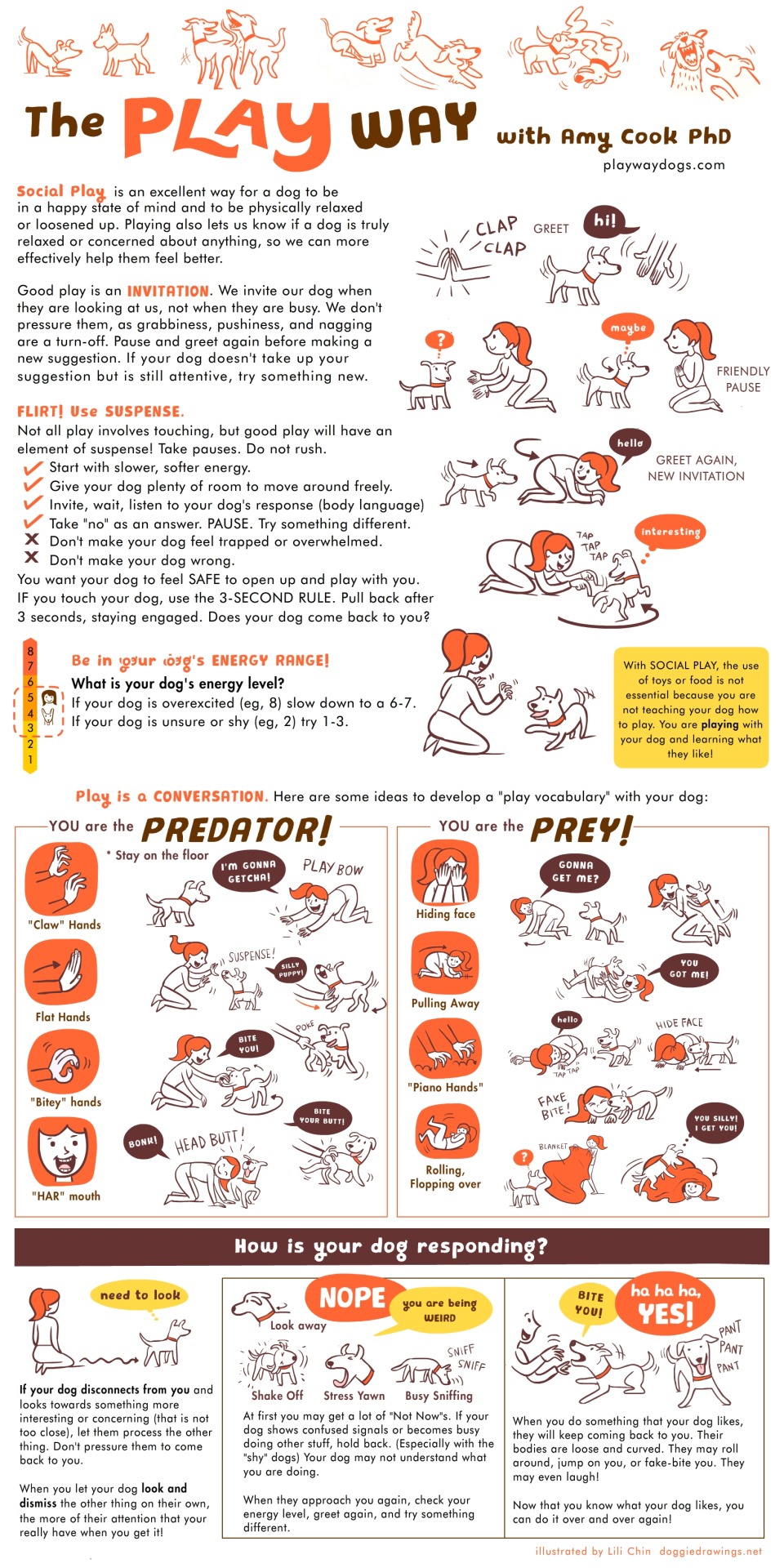
In January this year, I attended Dr. Amy Cook��s PLAY WAY seminar at Pasadena Humane Society.
The seminar was about “social play” as a tool for rehabilitating reactive/stressed/fearful dogs. “Social Play” has been defined as something different from playing with toys (tug, fetch, etc) It is literally “goofing around” with your dog in a way that they like that makes them happy. Body language responsiveness, movement and timing is everything.
Not only did we get to see some inspiring and entertaining video footage of Amy Cook playing with her dogs, some attendees had also brought their own dogs to play with, while Amy offered coaching.
It was an amazing and delightful experience and I couldn’t wait to get home to play with my 15 year old Boogie who hasn’t been interested in Tug or Fetch in over a year due to his vision loss.
The Play Way class was like learning a new language, a new vocabulary. You had to be there.
As far as I know, there is no other information out there on how to play with your dog without using toys, and until this seminar, I had no idea that dogs LAUGH. (I don’t think Boogie has ever laughed)
This infographic cannot possibly do justice to all the material covered in the Play Way seminar, which also focused on play as “therapy”. For now, I hope this is enough to pique everyone’s interest in the subject. This is another way to be mindful and respectful of our dog’s body language and of our own body language. I still have a lot to learn!
- Lili
LINKS:
Download Poster here in high-res (shareable without modifications, and with attribution)
Amy Cook’s online Play Way class
Doggie Language - my new forthcoming book will have more art on dog body language.
6K notes
·
View notes
Photo
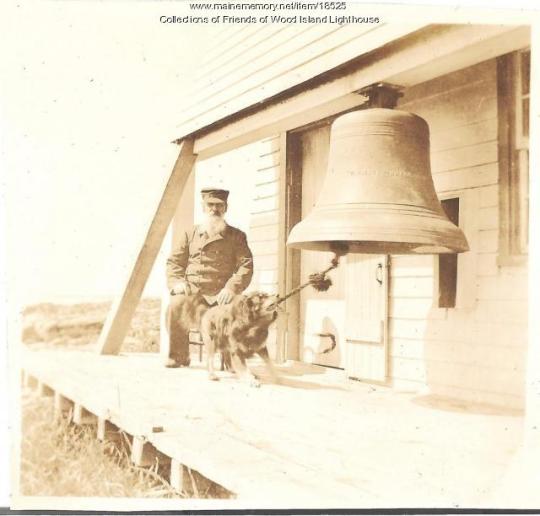
i am BEGGING everybody to please look at this picture of a dog who worked at Wood Island Lighthouse in Biddeford, Maine in 1903. his name was Sailor and it was his job to ring the foghorn. he was famous nationwide. mariners passing nearby the lighthouse would toot their horns in greeting and he would get very excited and ring the foghorn as a hello
source: https://www.mainememory.net/artifact/18525
9K notes
·
View notes
Text
sometimes i just get obsessed with how lonely humans are, as a species. we see faces everywhere. we have stories about beings living in the things of our world that go back as long as we’ve been telling stories. we’ve been sending our songs and dances up to the sky for millennia, and when we figured out there was something beyond our sky, we started sending songs out there too. we tell each other about fairies and bigfoots and worlds lying under the skin of our own. we name robots and look for personality in code. we tamed dogs to have friends to hang out with and we dream about aliens. we see life everywhere. what is it, exactly, that we’re trying to replace? what left us alone in the first place?
46K notes
·
View notes
